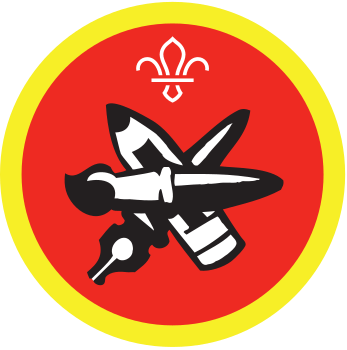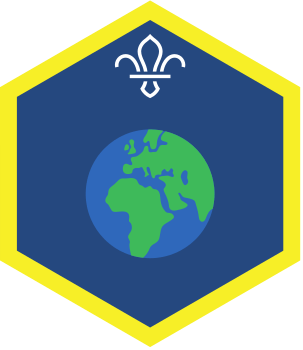
Messy Nessies
You’ll need
- Clean items of recycling
- Craft materials (for example, tissue paper, pipe cleaners, stickers)
- Scissors
- Coloured pens or pencils
- Sticky tape
- String
- A blue or green sheet of tarpaulin or other material
Before you begin
- Use the safety checklist to help you plan and risk assess your activity. Additional help to carry out your risk assessment, including examples can be found here. Don’t forget to make sure all young people and adults involved in the activity know how to take part safely.
- Make sure you’ll have enough adult helpers. You may need some parents and carers to help if you’re short on helpers.
Collecting recycling
- The week before the session, ask the group to bring with them some clean recycled items of rubbish to the next meeting. This should include bottles, cans, card, paper, packets or tins.
Get messy
- Lay out the blue or green sheet on the floor of the meeting place and fix to the ground with some tape.
- Tell the group that the blue or green space is Loch Ness – a large lake in Scotland. See if they know anything about Loch Ness – they might have heard whispers about a certain mythical monster.
- The person leading the activity should put their recycled items on the blue or green sheet, wherever they like. Everyone else should do the same.
- Explain that rubbish that has been dropped often ends up in lakes. Items made of plastic are not natural and can harm the local plants and animals – even the local monsters!
Every item of plastic that has ever been created is still with us on the planet today. Find out more about the problems this creates for sea-life in Plastic Pollution Facts.
- Everyone could think together in groups about what kind of animals might live in the Loch and which might be affected by the dropped rubbish.
- The group is probably dying to talk about it, so the person leading the activity should ask what they know about the Loch Ness Monster, or ‘Nessie’.
- See what ideas the group have heard about what the monster is and what it might look like. Find out if anyone has seen any of the photographs which are supposed to show the monster.
In their groups, everyone could share their ideas on what Nessie looks like. Those with pens or pencils and paper to hand could make a rough sketch of what they think to show the others.
- If they have not already, everyone should get into groups of three or four people. Using the rubbish on the blue sheet, each group should make a model of what they think Nessie looks like. Each Nessie should be able to swim, so that it can live in the Loch. Everyone should try to make body parts that can move on their own, to help Nessie get about. Use string, glue and tape to fix each part in place.
The person leading the activity should watch the groups carefully if they are using tin cans or other recycled goods that may have sharp edges. They should also encourage the groups to try and use as much of the rubbish as they possibly can.
- Once the models are completed, everyone should line up their Nessies in the centre of the blue or green sheet for everyone to look at. A person from each group should talk about their model and explain why they added the features they did. They should also mention the items of rubbish they used.
Reflection
The group have made models of the mythical Loch Ness Monster. They’ve already talked about the monster, and some of the ideas people have had about how and why Nessie could exist. Is anyone a believer? What kind of creatures do the group know about that might be the same (or similar) to Nessie? In the past, it has been suggested that Nessie is a giant eel, a sea dinosaur (or ‘plesiosaur’) and even an elephant. Which of these is the most likely?
To make their models, the group used recycled materials. Recycling is vital to help stop rubbish ending up in the sea and in lakes like Loch Ness. Why was it useful for the group to use their recycled goods to make models? What might’ve happened to the bottles, tins and other items, had they not been used for this activity?
Safety
All activities must be safely managed. You must complete a thorough risk assessment and take appropriate steps to reduce risk. Use the safety checklist to help you plan and risk assess your activity. Always get approval for the activity, and have suitable supervision and an InTouch process.
- Scissors
Supervise young people appropriately when they’re using scissors. Store all sharp objects securely, out of the reach of young people.
- Glue and solvents
Always supervise young people appropriately when they’re using glue and solvent products. Make sure there’s plenty of ventilation. Be aware of any medical conditions that could be affected by glue or solvent use and make adjustments as needed.
- Sharp objects
Teach young people how to use sharp objects safely. Supervise them appropriately throughout. Store all sharp objects securely, out of the reach of young people.
- Rubbish and recycling
All items should be clean and suitable for this activity.
- Monster buffs might have some more detailed plans for creating their Nessies. Allow some more time for those who wish to create and test models with multiple moving parts.
- Lend a hand to those who might be struggling to use the recycled goods. Suggest which items could be used where. You could also find some other drawings of Nessie made by other people to inspire those who are stuck.
Assist those who need help with metal or plastic materials.
All Scout activities should be inclusive and accessible.
The group should do some research on pollution and how rubbish that humans drop can seriously harm plants and animals. Everyone should find out about one animal or plant that has either become extinct (is no longer alive) or one that is not as common as it used to be. Find out how rubbish like plastics has made life for these plants and animals more difficult.
Let young people use their creativity and imagination when making Nessie models. After all, who can say what the monster is really like anyway?!



